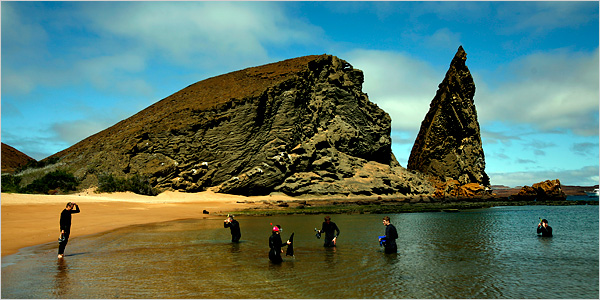 [Image: ©Michael Nagle for The New York Times].
[Image: ©Michael Nagle for The New York Times].Seeing this photo of the Galapagos Islands, with its strange, almost hand-painted color scheme, like something from an old British postcard, made me wonder if perhaps we might yet discover a way to deep-inject colored dyes into active magma chambers, producing technicolor flows of liquid rock in a million years' time.
Volcanoes will erupt in Chile, forming bright green hillsides, yellow cliffs dotted with blue boulders. A fine pink gravel will wash up and down the steaming beach.
So can we introduce color into underground reservoirs of liquid rock – with the effect that, far after humans have died off, these weird and fantastic displays of dyed geology will arise, poking up beneath eroded soils, revealing themselves in fissures after earthquakes? Colored bulges of bedrock push toward the earth's surface, seeking the sun.
And isn't that exactly what will happen anyway, as mineral belts of industrial waste and plastics compress over time into new stratigraphies? We could pattern future hillsides like Scottish tartans. Like shirts from J. Crew. Like Sol Lewitt: give him a whole magma chamber to play with. Like some vast underground ink-jet cartridge ready to print colored landforms onto the surface of the earth.
Can we dye rock itself?
Unsupervised geological interventions are the future of landscape architecture.
What Ted Turner did for film, we will do for geology: the re-colorization of the planet.
(Photo courtesy of The New York Times).
No comments:
Post a Comment